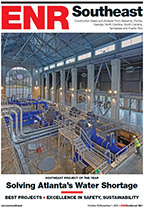In egypts remote desert near Sudan, a fleet of floating pontoons is drilling, blasting and excavating a canal nearly 50 meters into Lake Nassers rock bed to feed one of the worlds biggest irrigation pumping stations, now being built on the reservoirs west shore. The $390-million job, to be completed in late 2002, will be followed by a $400-million project 130 miles south of Luxor to tap Nile River water.
Work is now 60% finished on housing for the 21-pump Mubarak Pumping Station in a 2-million cu-m dewatered pit. There, two drill barges are blasting rock to form a canal 4.6 kilometers into the lake. "We are still fine-tuning the blasting....We are taking it down in 10-m lifts," says Eddie McEwan, project director with London-based Skanska Cementation International. It leads the Egyptian European Japanese Consortium, which, won the turnkey contract three years ago.
Since starting its drill barge operation in early 1999, the consortium has dug about half the 5.5 million cu m of rock that will come out of the 2.8-km wet section of canal. "Weve only just put our second drill and blast pontoon into the water," says Nigel King, Skanskas technical director. Two excavator arms on pontoons are removing rock down to 28 m, while hydraulic grabs on a catamaran extract from greater depths.
The consortium hopes to make up time lost due to mobilization snags in the remote location, says King. Pontoons, each weighing up to 500 tonnes, were trucked in pieces from Safag, an Egyptian Red Sea port three days away along special routes. Most other supplies come from Europe. The consortium is more advanced along the 1.8-km canal section, where it is excavating another 5.5 million cu m in dry areas up to the 60-m-deep pump basin. Hitachi Ltd., a Japanese consortium member, will soon install the 21 pumps. Together, they will raise by 54 m as much as 334 cu m per sec of water. The government may also order three more pumps. Project officials say there is room for two sets of 12 pumps, back to back, in the 139-m-longx39.5-m-wide housing.
So far, the rock is good for pumphouse foundations, says Alain Deforche, chief structural engineer with French design firm Sogreah, which is helping monitor work for the Ministry of Water Resources and Irrigation. But dozens of micropiles are needed to seismicly bolster the 53-m-tall building. Germanys Lahmeyer International and Cairo-based Hamza Associates are project designers.
Lahmeyer is also on the governments design team for the follow-on 330-m-long dam at Naga Hammadi that would replace a structure built in the early 1900s. The estimated $400-million contract, soon to be let, involves diverting the Nile through a 1.1-km-long canal. This would allow the barge to build in the dry, with foundations up to 25 m below the normal river level. Acting as a weir, the seven-gate dam will raise water by 4 to 8 m for irrigation and drive a 64-Mw hydroelectric plant, says Winfrid Guth, Lahmeyers project manager.


Post a comment to this article
Report Abusive Comment